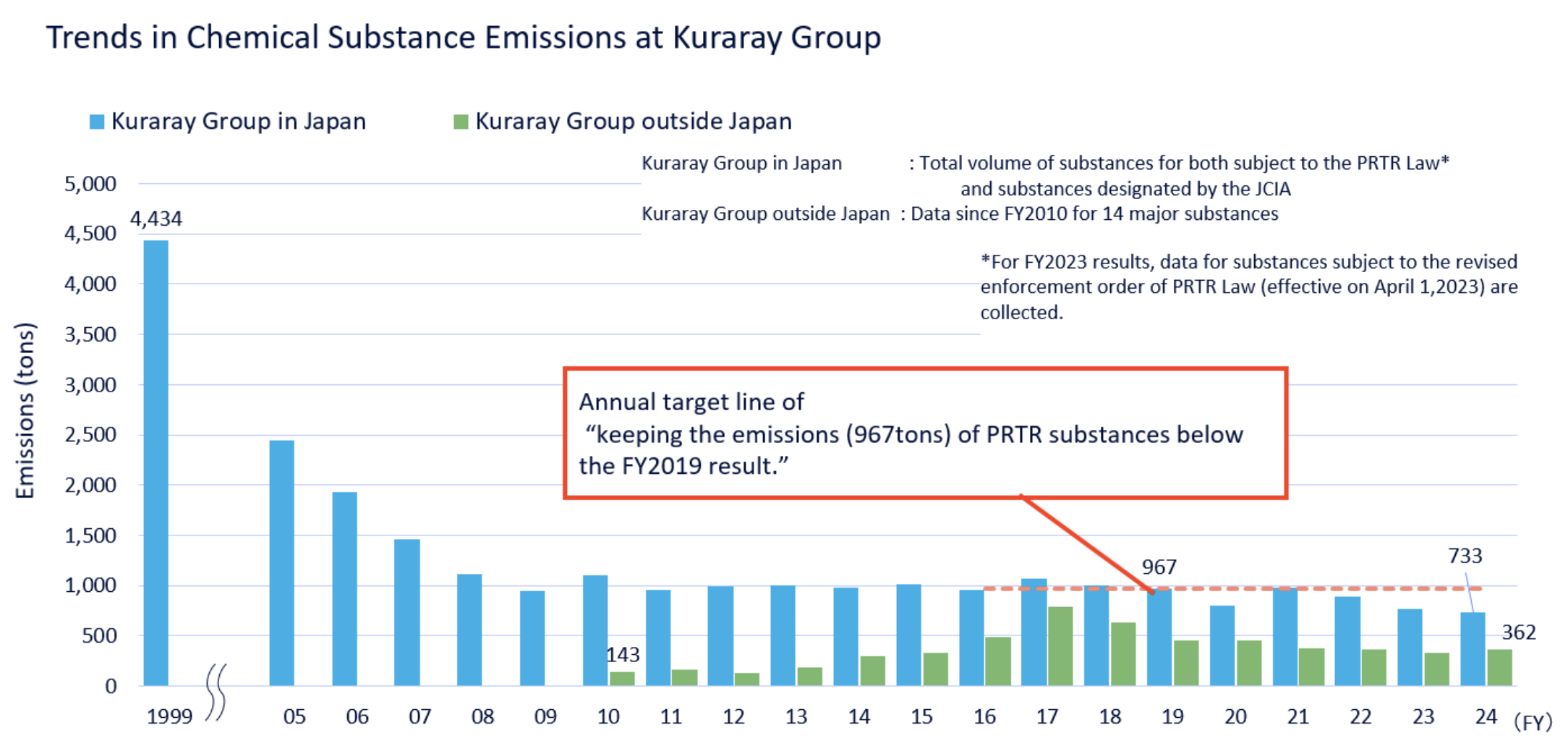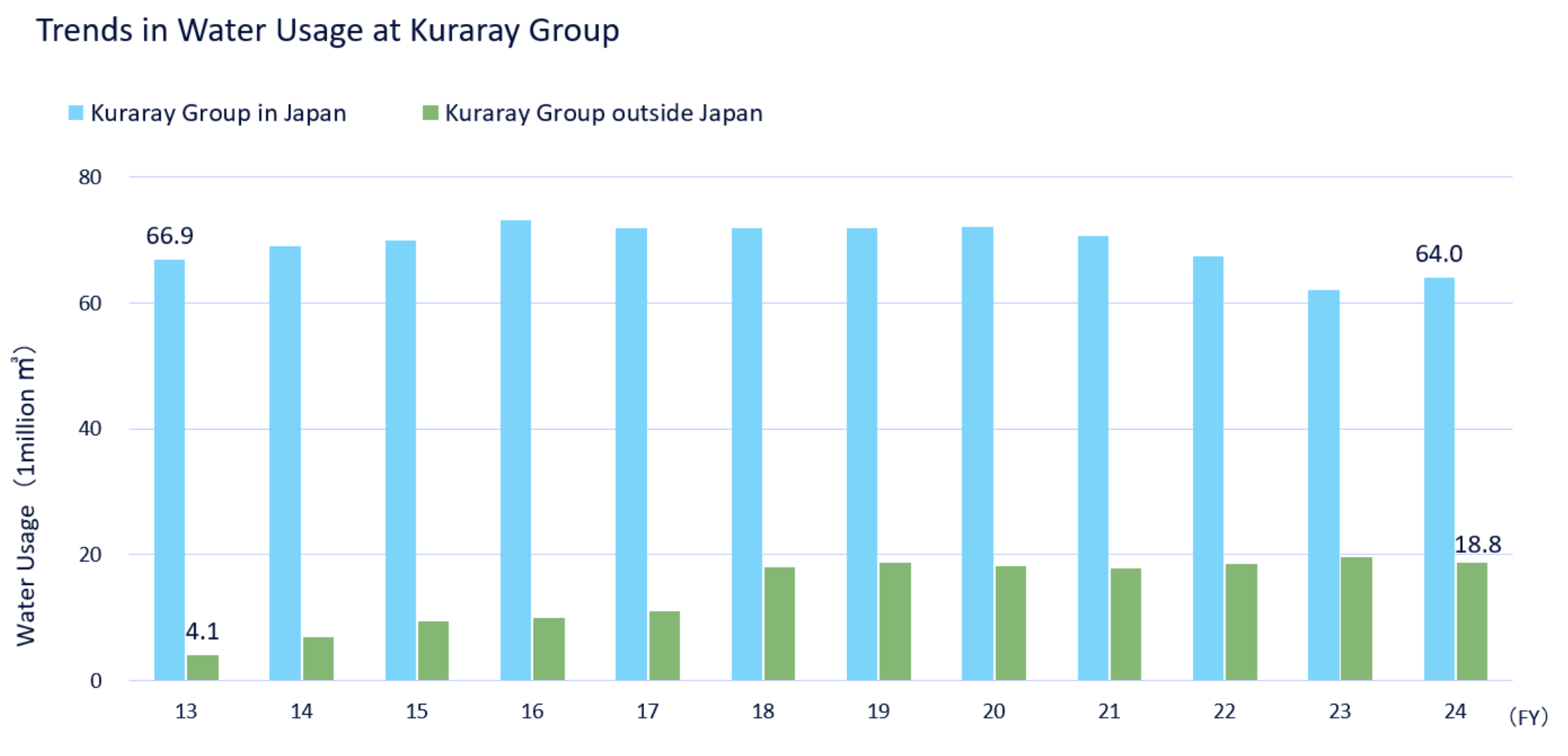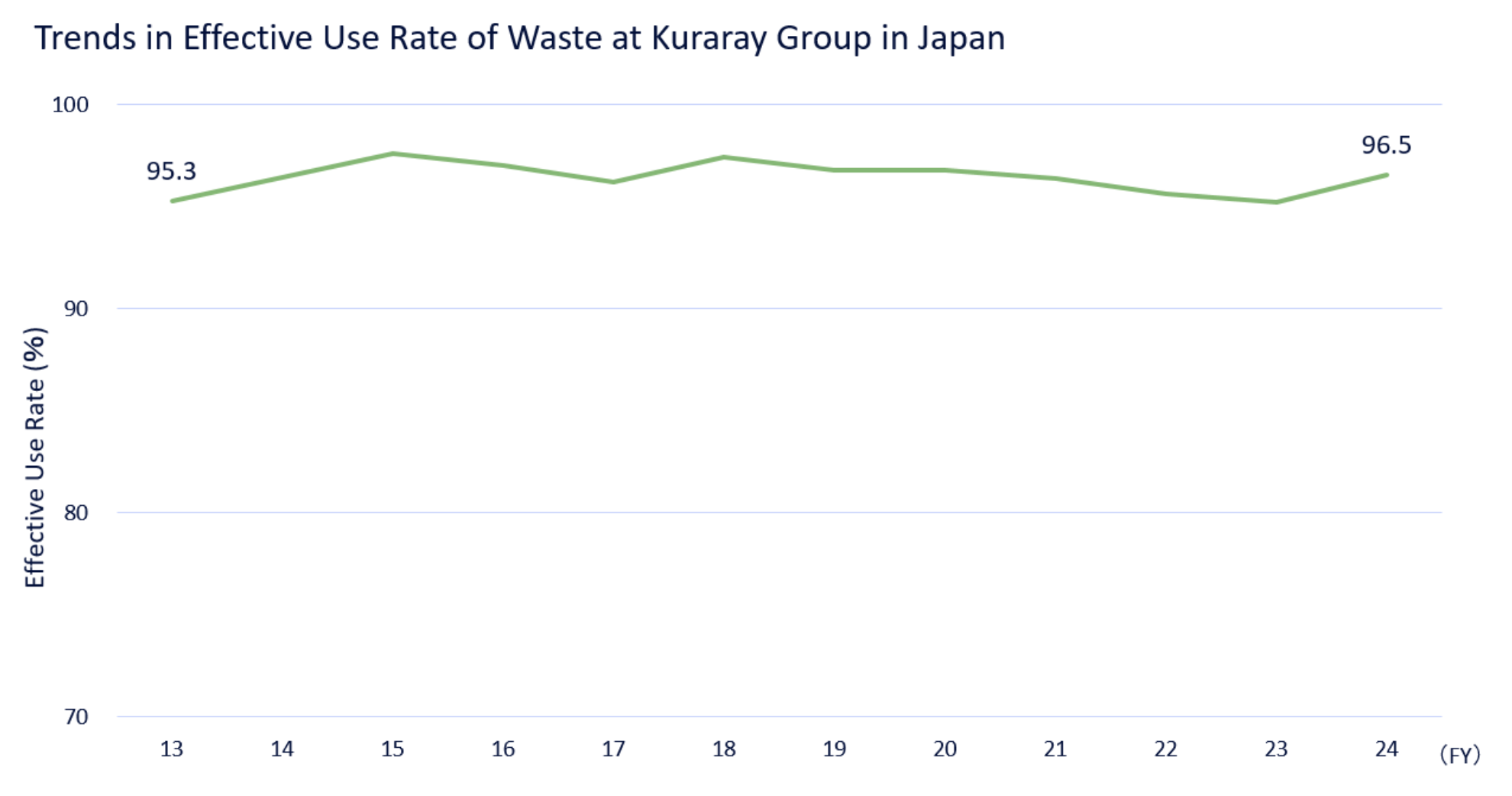Reduction of Environmental Load
Emission Management of Chemical Substances
Based on the Law Concerning Reporting, etc. of Pollutant Release and Transfer Register (PRTR Law), the Kuraray Group in Japan surveys and ascertains the annual emissions of chemical substances subject to PRTR Law and reports the results to the national government. The Kuraray Group similarly discloses on its official website, etc. emissions of chemical substances not only covered by the PRTR Law, but also designated by the Japan Chemical Industry Association (JCIA). In addition to these chemical substances, we are taking the actions indicated in the table below with regard to persistent organic pollutants (POPs), volatile organic compounds (VOCs), hazardous atmospheric pollutants (HAPs), and particulate matter (PM).
Environmental Data
| Classification | Chemical substances | Actions to be taken |
|---|---|---|
| POPs | Polychlorobiphenyl (PCB) | Storing, managing, reporting and processing to render harmless in accordance with the Law Concerning Special Measures against PCB Waste. (Time limit is set for harm-free processing) |
| Dioxin and the like | Included as substances in the pollutant release and transfer register (PRTR) and emissions are measured and reported as PRTR substances. (Please visit Kuraray website for emissions by each plant) | |
| Substances other than the above | Not applicable to Kuraray manufacturing and use | |
| VOC HAP |
Included as substances in the pollutant release and transfer register (PRTR) and emissions are measured and reported as PRTR substances. (Total emissions are reported in Material Flow. Please visit Kuraray website for emissions by each plant) | |
| PM | Emissions of particles of soot are reported in Material Flow | |
| PRTR | Emissions of substances applicable to the law and to the list compiled by the Japan Chemical Industry Association are measured and reported (Total emissions are reported in Material Flow. Please visit Kuraray website for emissions by each plant) | |
The Kuraray Group in Japan had made a major capital investment until around 2008 to reduce emissions of chemical substance, and has achieved about an 80% reduction compared to 1999. Since then, we have set limits on the amount of Japan Chemical Industry Association (JCIA)-designated Pollutant Release and Transfer Register (PRTR) substances* under the concept that, even if the scale of business expands, we will not increase emissions outside production sites from the base year. To achieve this target, when considering construction of new production facilities, we examine and carry out investment projects with consideration of measures to prevent an increase in emissions of chemical substance. In 2024, due to scheduled maintenance work at one of the facilities, the production volume decreased, resulting in a reduction in emissions from 770 tons in 2023 to 733 tons, achieving the target of less than 967 tons. Going forward, we will continue to take measures to prevent an increase in emissions.
The policy of the Kuraray Group outside Japan is to continue to comply with the rigorous environmental regulations of its respective countries and regions where each production site is located and to conduct quantitative control. Until 2017, total emissions were on an upward trend due to the incorporation of businesses and the construction and expansion of production facilities. However, emissions have been decreasing since 2018 due to measures to expand waste gas treatment equipment at one of the sites and improve operational control. In 2024, emissions increased to 362 tons from 331 tons in 2023, due in part to increased production volume at some sites.
* Substances subject to the PRTR Law and substances designated by the Japan Chemical Industry Association

【Notes】As a result of the change in months in each fiscal year, the environmental data and information contained in this report including graphs are as follows.
- ・Before fiscal 2013: Actuals in 12 months from April to March of the following year
- ・Fiscal 2014: Actuals for 9 months from April to December + Actuals for January to March 2014 (or estimated value) [Partially overlaps with fiscal 2013]
- ・After fiscal 2015 : Actuals for 12 months from January to December
Effective Use of Waste
The amount of waste generated by the Kuraray Group in Japan increased from 62.8 thousand tons in 2023 to 66.3 thousand tons in 2024 due to the increase in production volume compared to the previous year. We carried out measures to reduce the amount of waste generated by 1.5 thousand tons through the activities such as improving product yields, sorting and recycling of waste into raw materials at each production site of Kuraray and affiliated company. As a result of our efforts to effectively use of waste generated through recycling and energy recovery, the rate of effective use was 96.5%. In recent years, restrictions on waste exports have become stricter, and it remains difficult to secure waste disposal company in Japan. Going forward, we will continue to strive to implement measures to reduce the amount of waste generation.
The amount of waste generated by the Kuraray Group outside Japan increased due to the acquisition of the vinyl acetate business in 2014 and the activated carbon business in 2018, but it has remained nearly constant since then. In 2023, the amount of waste generated increased to 91.8 thousand tons due to temporary waste generation at one of the production sites, but in 2024, due in part to the planned shutdown of facilities at several sites in the United States, the amount decreased significantly to 60.8 thousand tons. In addition, affiliated companies outside Japan are also engaged in activities to improve product yields and collect and effectively use waste materials generated at our production sites. Going forward, each production site will continue to comply with its own legal requirements and work on measures to reduce waste generation.
The sales intensity of waste generation in the Kuraray Group, which was set as the target for reduction of environmental load in the Sustainability Medium-Term Plan for Planet, reduced by 38.5% (improvement) in 2024 compared to 2019, far exceeding our target of the "Reduction (improvement) of 5% or more in 2026". Going forward, we will continue to work on further improvement of sales intensity through the activities of various measures for waste reduction.
<'high-volume generators' under the Plastic Resource Circulation Act>
(high-volume generators: Industrial waste of plastic-using products, etc. 250 tons/year or more)
The table below shows the business operator in the Kuraray Group that fall into the category of 'high-volume generators' under the Plastic Resource Circulation Act in 2024. The Kuraray Group makes effective use of most of the generated industrial waste of plastic-using products, etc. through recycling and heat recovery. In addition, waste and other materials containing vinyl chloride generated by one of the affiliated companies are being disposed of by final disposal (in landfill) due to the difficulty of recycling and energy recovery, but we are switching some of the waste to uses that can be utilized as effectively as possible. We will continue to implement measures to reduce the amount of waste generated by working on improving process yields and other measures, as well as promoting the effective use of the waste generated.
| Company | Amount of waste (ton) | Effective use (ton) | Final disposal (ton) | Effective utilization rate | Final disposal rate |
|---|---|---|---|---|---|
| Kuraray Co., Ltd. | 20,479 | 20,436 | 32 | 99.79% | 0.16% |
| Kuraray Saijo Co., Ltd. | 320.3 | 319.8 | 0.5 | 99.86% | 0.14% |
【Notes】As a result of the change in months in each fiscal year, the environmental data and information contained in this report including graphs are as follows.
- ・Before fiscal 2013: Actuals in 12 months from April to March of the following year
- ・Fiscal 2014: Actuals for 9 months from April to December + Actuals for January to March 2014 (or estimated value) [Partially overlaps with fiscal 2013]
- ・After fiscal 2015 : Actuals for 12 months from January to December
Effective Use of Water Resources
The Kuraray Group, including our overseas affiliates, is not engaged in production activities in areas where our business activities significantly impact on local water resources. However, we have been engaging in business activities recognizing that water resources are vital.
In 2024, water consumption (excluding seawater) of the Kuraray Group in Japan increased from 2023 to 64.0 million m3. The number of operating days for power generation turbines at one of the plants was higher than the previous year, resulting in an increase in cooling water usage. Even though Kuraray production sites in Japan are well located in terms of water resources, we believe that it is necessary to conduct business activities by considering the long-term prospects for water supply, such as the risk of a water shortage caused by climate change due to global warming. We also continue to “reuse water” by such as reusing cooling water for boiler water. We will keep track of water consumption trends while continuously reducing our water consumption and effectively using water resources.
The water consumption of the Kuraray Group outside Japan has increased since 2014 due to the incorporation of businesses through M&A, such as the acquisition of the vinyl acetate business and the activated carbon business, but it has remained nearly constant since then. Each site of affiliated company outside Japan has continued to implement measures to reduce water consumption, such as improving product yield, reusing recovered water, and so on. Compared to 2023, water consumption decreased in 2024, totaling 18.8 million m3 due to reduced cooling water usage resulting from the planned shutdown of facilities at several sites in the United States.
The sales intensity of water usage in the Kuraray Group outside Japan, which was set as the target for reduction of environmental load in the Sustainability Medium-Term Plan for Planet reduced by 23.9% (improvement) in 2024 compared to 2019, far exceeding our target of the "Reduction (improvement) of 5% or more in 2026". Going forward, we will continue to work on further improvement of sales intensity through the activities of various measures for water usage reduction.

【Notes】As a result of the change in months in each fiscal year, the environmental data and information contained in this report including graphs are as follows.
- ・Before fiscal 2013: Actuals in 12 months from April to March of the following year
- ・Fiscal 2014: Actuals for 9 months from April to December + Actuals for January to March 2014 (or estimated value) [Partially overlaps with fiscal 2013]
- ・After fiscal 2015 : Actuals for 12 months from January to December
Conservation of Biodiversity
The Kuraray Group believes that continuing our efforts to implement measures in global warming prevention, control of chemical substance emissions, reduction and effective use of waste, and effective use of water resources will lead to biodiversity conservation. We formulated the Action Policy for Biodiversity Conservation and have been promoting activities and the development of technologies and sale of products that contribute to biodiversity conservation. Refer to following examples of environmental conservation activity, employee volunteers at some Kuraray plants engage in forest conservation activities, cleanup activity, and endangered species protection activities, in cooperation with local governments and others.
<Examples of environmental conservation activities>
| Kurashiki Plant |
|
|---|---|
| Okayama Plant |
|
| Saijo Plant |
|
| Niigata Plant |
|
| Kashima Plant |
|
| Tsurumi Plant |
|
| Kuraray America, Inc. |
|
| MonoSol, LLC |
|
| Plantic |
|



